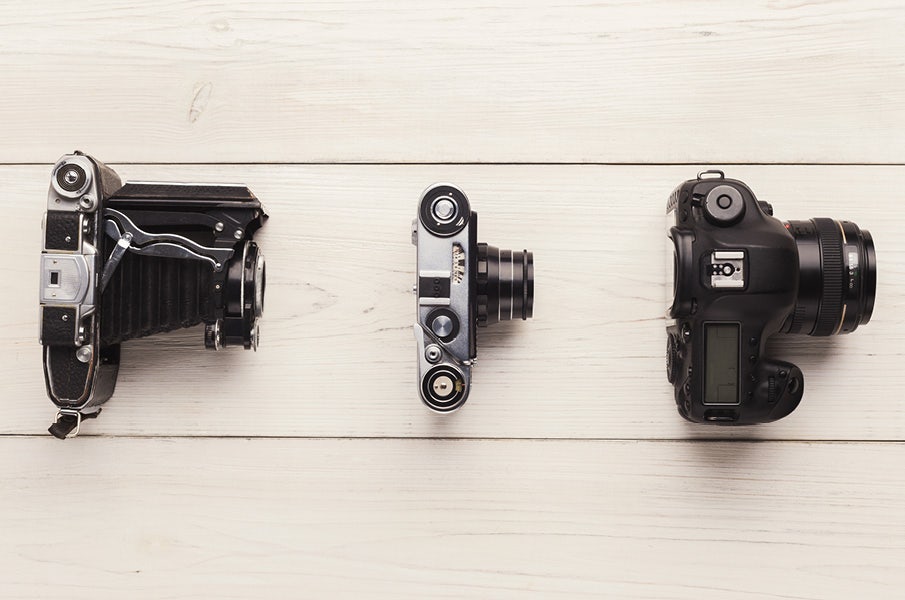
In the ever-evolving landscape of technology, the camera stands as a beacon of relentless innovation. Its journey from the 1980s to the 2020s is a fascinating tale of progression from analog to digital platforms, revolutionizing the way we capture and cherish moments. Let's take a nostalgic walk down memory lane, witnessing the remarkable evolution of camera technology over these pivotal decades and how Camera House has been there, every step of the way.
The 1980s: The Reign of Film Cameras
The 1980s were characterized by the dominance of film cameras. These were the days of rolling up the film manually, setting the perfect frame, and then waiting with bated breath for the film to develop. The cameras during this period were mainly SLRs (Single-Lens Reflex) and compact cameras, which offered photography enthusiasts a hands-on experience in capturing moments with a touch of artistry.
Film photography was not just a process but an art form, where each click of the shutter was a brushstroke on a canvas that would only reveal itself once developed. The tangible nature of film and the intricate process of developing prints made photography a deeply personal and rewarding experience.


The 1990s: Transition to the Digital Realm
As the world stepped into the 1990s, the camera industry started to witness a seismic shift from analog to digital platforms. The birth of digital cameras marked a new era, where images could be viewed instantly on LCD screens, a feature that revolutionized the concept of photography. This period saw a gradual decline in film cameras as digital cameras offered a more convenient and efficient alternative for capturing moments.
The 1990s can be termed as a transitional phase, where the world was slowly but steadily adapting to the digital wave that was sweeping the camera industry. The convenience of storing thousands of images on a single memory card and the ability to manipulate photos using software applications were features that propelled the popularity of digital cameras.
The 2000s: The Smartphone Takeover
The 2000s were a watershed moment in the evolution of camera technology, marked by the advent of smartphones equipped with cameras. The initial years saw basic cameras in phones, but as the decade progressed, the cameras in smartphones became more sophisticated, offering features and functionalities that rivaled standalone digital cameras.
The integration of cameras into smartphones democratized photography, making it accessible to a much wider audience. The 2000s were characterized by an explosion of photographic content, fueled by the rise of social media platforms where people could instantly share their captured moments with the world. Photography became not just a hobby but a vital part of daily life, interwoven with the burgeoning culture of social media sharing.
The 2020s and Beyond: A Renaissance of Film Photography
Entering the 2020s, the camera industry is experiencing a nostalgic resurgence, a kind of renaissance of film photography. In a world inundated with digital images, there is a growing community of photography enthusiasts who are returning to the roots of photography, embracing the authentic and organic nature of film photography.
This decade is witnessing a harmonious blend of the old and the new, where film cameras are making a comeback, signifying a renewed appreciation for the tactile and personal touch that film photography offers. The resurgence of film photography is a testament to the fact that in the world of photography, the old and the new can coexist, offering a rich and diverse tapestry of photographic experiences.
Camera House is experiencing this in the increased amount of customers coming to our shops to print their films. We offer film printing services across most, if not all of our retail locations, so don’t hesitate to come in or give us a call and we will be able to assist you!
In Conclusion
The journey of camera technology from the 1980s to the 2020s is a vivid portrayal of technological innovation and adaptation. From the tactile experience of film cameras to the convenience and functionality of digital platforms, and now a harmonious blend of both worlds, the camera industry continues to thrive and evolve, offering an ever-enriching photographic experience.
As we continue to navigate through the 2020s, we can only wonder what the future holds for camera technology. Will it be a further fusion of analog and digital elements, or will we witness the birth of a new era of photographic innovation? Only time will tell, as we continue to capture moments, one click at a time. Nevertheless, Camera House will always be there.
